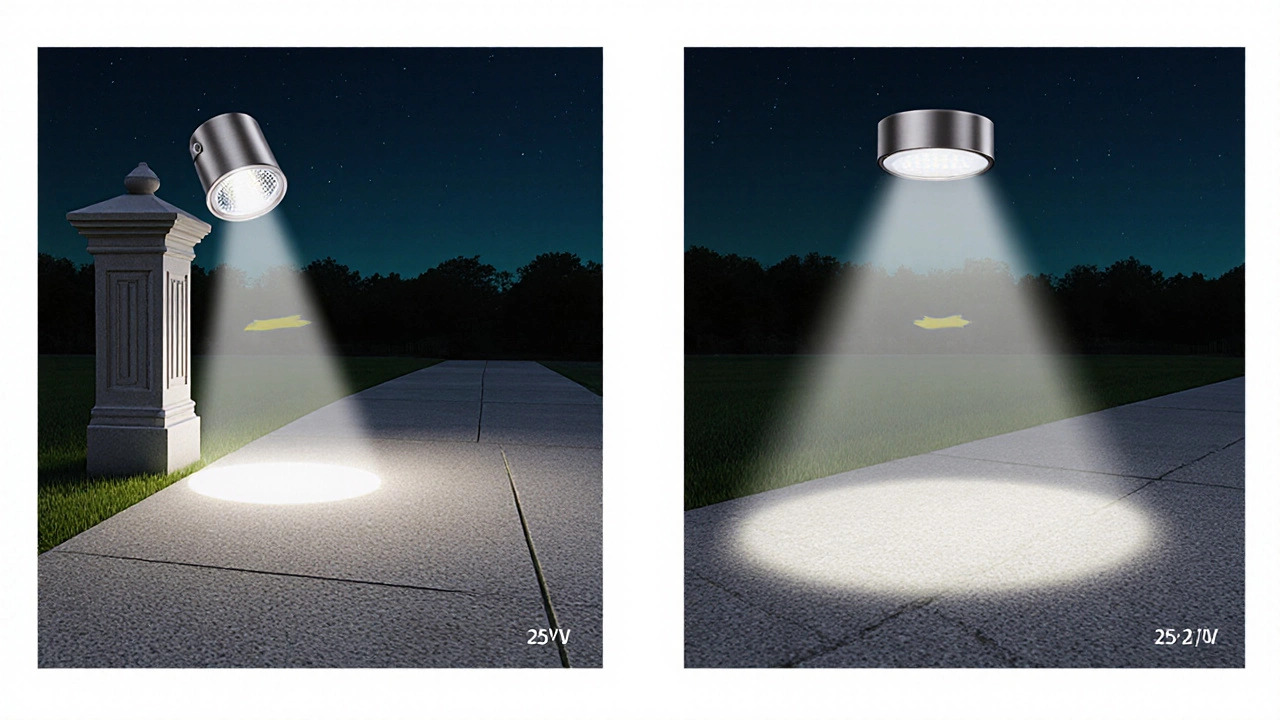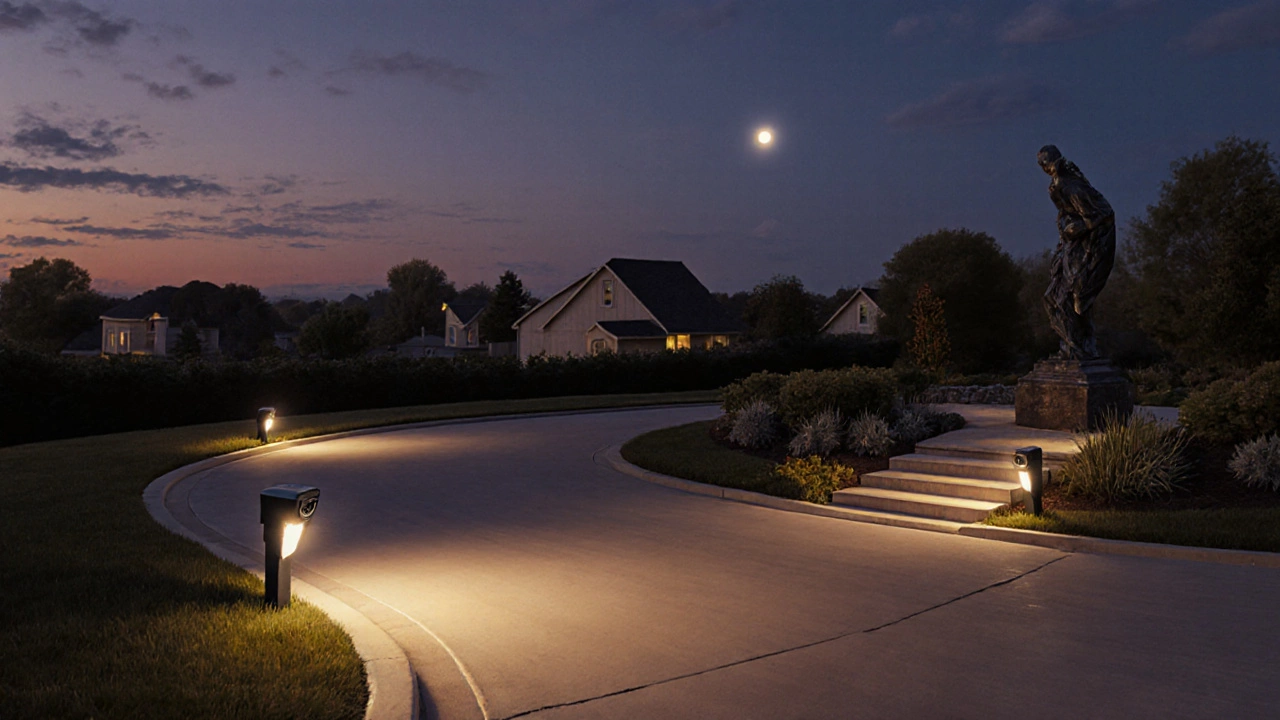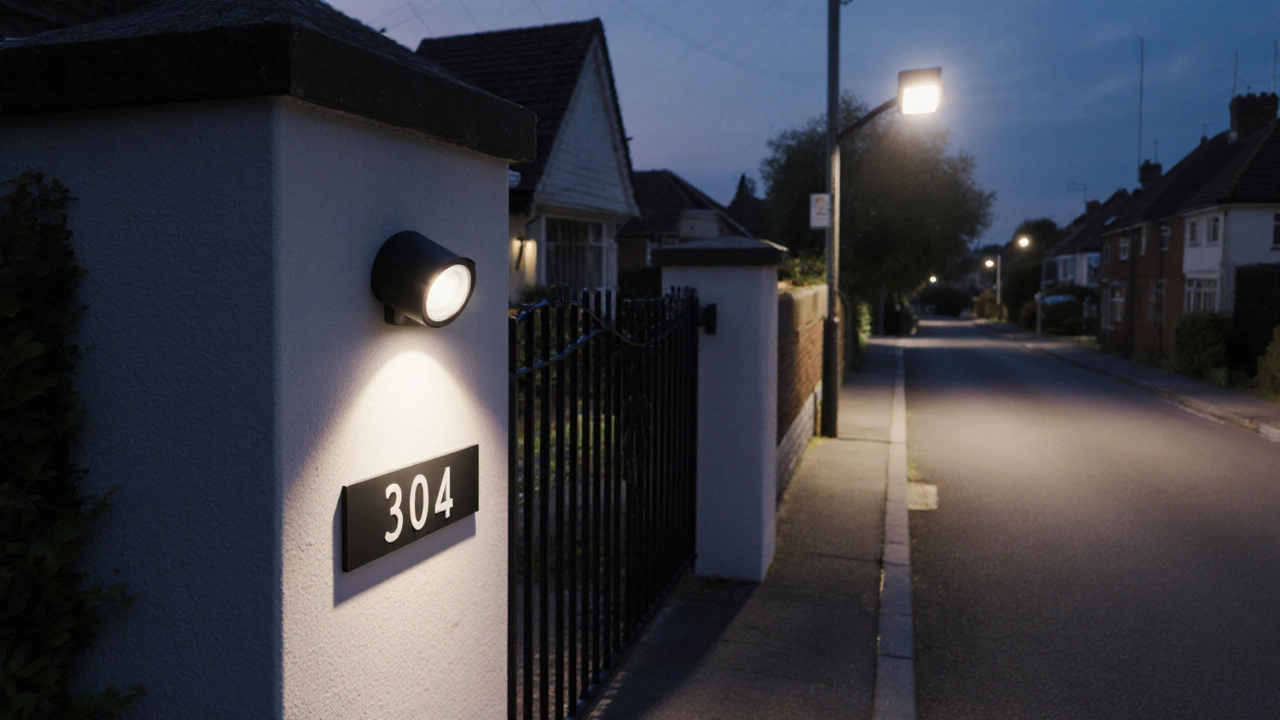Driveway Lighting Calculator
Choose Your Driveway Type
Select your driveway characteristics to get the best lighting recommendation
Recommended Solution
Key Benefits
Choosing the right light for your driveway can feel like a toss‑up between a focused spotlight and a wide‑angle floodlight. Both promise safety, curb appeal, and a deterrent against nosy neighbors, but they work very differently. Below we break down the two options, compare specs, and give you a clear game plan so you can decide what fits your driveway’s shape, budget, and security needs.
What Exactly Is a Spotlight?
Spotlight is a directional outdoor fixture that projects a narrow beam-typically 15° to 45°-to highlight a specific point or small area. Modern LED spotlights deliver 1,500‑3,000 lumens using only 15‑30 watts, and many include motion sensors or Bluetooth control. Because the light is concentrated, a 1,500‑lumen spotlight can create a bright hotspot that’s 47% more intense than a floodlight with the same lumen output.
What Is a Floodlight?
Floodlight is a wide‑angle outdoor fixture that spreads light over a large area, usually with a beam angle of 90° to 120° or more. For a typical residential driveway, floodlights deliver 1,500‑3,000 lumens at 20‑40 watts. Their broader coverage means you can light an entire driveway with a single unit mounted 8‑10 feet high, but the intensity at any single spot is lower than a spotlight’s hotspot.
Beam Angle Matters: Coverage vs. Intensity
- Spotlight: Narrow beam (15°‑45°) - perfect for highlighting gates, house numbers, or a tricky bend.
- Floodlight: Wide beam (90°‑120°) - ideal for blanket illumination of straight, unobstructed driveways.
Imagine shining a flashlight on a wall. A tight beam creates a bright circle; a wide beam lights the whole wall but with less punch. Your driveway works the same way.
Energy Use and Lifespan
Both fixtures now come in LED form, delivering 80‑100 lumens per watt. A 2,000‑lumen floodlight at 30 watts uses about 0.03 kWh per hour, while a comparable spotlight at 25 watts uses 0.025 kWh. Over a year of nightly operation (4 hours), the floodlight costs roughly $2.63 in electricity (U.S. average $0.13/kWh) and the spotlight $2.19. Lifespans range from 25,000‑50,000 hours, meaning you’ll likely replace the fixture only once every 7‑15 years.

Installation Height and Coverage Distance
| Attribute | Spotlight | Floodlight |
|---|---|---|
| Typical Mount Height | 6‑8 ft | 8‑10 ft |
| Effective Range | 35‑40 ft (focused) | 20‑25 ft (uniform) |
| Beam Angle | 15°‑45° | 90°‑120° |
| Power Consumption | 15‑30 W | 20‑40 W |
| Cost per Unit (mid‑range) | $28‑$95 | $35‑$120 |
Security and Safety Impact
Lighting isn’t just about aesthetics. A Safe Home Organization (2022) study showed that well‑lit driveways cut nighttime trips by 37% and slashed attempted break‑ins by 68%. Floodlights win for deterrence because they bathe the entire approach in light, making it harder for an intruder to stay hidden. Spotlights, on the other hand, excel at drawing attention to high‑value targets-like a gated entry or a sleek mailbox-so visitors feel welcome while still being seen.
Cost, Maintenance, and Smart Features
Basic floodlights start around $35, while quality spotlights begin at $28. A full‑coverage setup using three floodlights might cost $120‑$360. To achieve the same uniform glow with spotlights, you could need five‑to‑seven units, pushing the total to $200‑$500. Maintenance differs too: floodlights collect about 22% more debris due to larger housings, meaning a quick wipe‑down every few months is essential.
Smart integration is now common. About 63% of new driveway lighting installs (NuWatt market data, Q2 2023) include Wi‑Fi or Bluetooth modules for scheduling, remote on/off, and linking to home‑security cameras. Motion sensors also vary: floodlights cover a 180° detection zone, while spotlights let you aim the sensor at a specific threat vector, reducing false alarms.

When to Choose One Over the Other
- Straight, Wide Driveways (≤15 ft wide): Floodlights give you the best value-one or two fixtures cover the whole length with minimal wiring.
- Curved or Obstructed Paths: Combine a central floodlight at the entrance with spotlights aimed at bends, steps, or decorative columns.
- Showcasing Architecture: Spotlights highlight a front door, lanterns, or a sculptural tree, adding curb appeal without over‑lighting.
- Budget Constraints: Floodlights are cheaper per square foot of coverage; spotlights become cost‑effective only when you need precise accenting.
- Smart Home Integration: Both support apps, but many newer floodlights include built‑in cameras (e.g., Ring Floodlight Cam), merging illumination and surveillance.
In practice, experts from Logos Lighting (2023) and Thunder Lighting Supply (2023) recommend a layered approach: a low‑profile floodlight at each driveway mouth for broad visibility, plus a few low‑voltage spotlights along the edges or at trouble spots.
Pro Tips for a Seamless Install
- Mount floodlights 8‑10 ft above ground to spread light evenly; lower heights create hot spots and shadows.
- Place spotlights 6‑8 ft high and angle them 15°‑30° downward to avoid glare on the road.
- Use ENERGY STAR‑certified LEDs to cut energy use by up to 75% compared with older halogen fixtures.
- Group fixtures on the same circuit and add a timer or motion sensor to prevent endless-on scenarios.
- Consider solar‑powered units if trenching is difficult; modern panels deliver 12‑18 hours of runtime on a clear day.
Future‑Proofing with Adaptive Lighting
New adaptive fixtures can switch between flood and spotlight modes automatically, based on motion data. NuWatt’s 2023 pilot showed a 53% boost in both security effectiveness and energy efficiency when lights dimmed to spotlight mode after detecting a visitor and widened back to flood mode when no movement was sensed for a minute. If you’re buying in 2025, look for “dual‑beam” or “adjustable‑angle” models that let you program the beam width.
Bottom Line: Pick What Serves Your Layout
If you have a straight, uncomplicated driveway, a single floodlight (or a pair for redundancy) will give you the safest, most cost‑effective solution. For anything with curves, steps, or decorative elements, add spotlights to target those problem areas. The best‑performing systems blend both, delivering blanket illumination while accenting the details that matter.
Do I need both a spotlight and a floodlight?
Most homeowners benefit from a hybrid setup. Floodlights handle overall visibility while spotlights draw attention to gates, numbers, or hazardous spots. This layered approach reduces shadows and boosts security.
Can I power driveway lights with solar panels?
Yes. Modern solar fixtures come with 12‑18 hour batteries and output comparable lumens to wired LEDs. They’re ideal where trenching is costly, but ensure the panel gets full sun for several hours a day.
What beam angle should I choose for a curved driveway?
Start with a floodlight at the entrance (90°‑120°) for general coverage, then add spotlights (15°‑45°) aimed at each bend or elevation change. This combination eliminates dark pockets.
How much electricity will a typical driveway lighting system use?
A 2,000‑lumen floodlight on 30 W plus two 1,500‑lumen spotlights on 20 W each run about 0.07 kWh per hour. Operating four hours nightly costs roughly $3.65 per year at the U.S. average rate.
Are smart‑controlled lights worth the extra cost?
If you already use a home‑automation hub, adding Wi‑Fi or Bluetooth lights lets you schedule on/off times, receive motion alerts, and sync with security cameras-adding convenience and an extra layer of deterrence for a modest price increase.

